

 |
Search the Site with

|
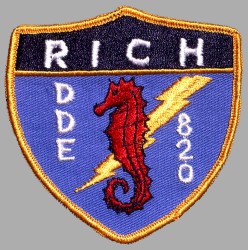 | 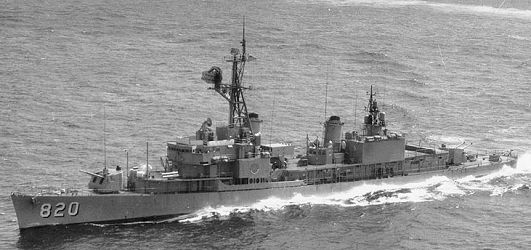 |
USS RICH was one of the GEARING - class destroyers and the second ship in the Navy to bear the name. After a collision in July 1977, the USS RICH was decommissioned on November 10, 1977, and struck from the Navy list on December 15, 1977. The destroyer was sold for scrap to Union Minerals and Alloys Corp., New York, NY, on December 5, 1979.
| General Characteristics: | Awarded: 1943 |
| Keel laid: May 16, 1944 | |
| Launched: October 5, 1945 | |
| Commissioned: July 3, 1946 | |
| Decommissioned: November 10, 1977 | |
| Builder: Consolidated Steel Corp., Orange, TX | |
| FRAM I Conversion Shipyard: New York Naval Shipyard, Brooklyn, NY | |
| FRAM I Conversion Period: January 1963 - November 1963 | |
| Propulsion system: four boilers, General Electric geared turbines; 60,000 SHP | |
| Propellers: two | |
| Length: 391 feet (119.2 meters) | |
| Beam: 41 feet (12.5 meters) | |
| Draft: 18.7 feet (5.7 meters) | |
| Displacement: approx. 3,400 tons full load | |
| Speed: 34 knots | |
| Aircraft after FRAM I: two DASH drones | |
| Armament after FRAM I: one ASROC missile launcher, two 5-inch/38 caliber twin mounts, Mk-32 ASW torpedo tubes (two triple mounts) | |
| Crew after FRAM I: 14 officers, 260 enlisted |
Crew List:
This section contains the names of sailors who served aboard USS RICH. It is no official listing but contains the names of sailors who submitted their information.
USS RICH Cruise Books:
USS RICH History:
USS RICH was laid down on 16 May 1944 by the Consolidated Steel Corp., Orange, Tex.; launched 5 October 1945; sponsored by Mrs. Ralph McM. Rich; and commissioned on 3 July 1946, Comdr. R. C. Houston in command.
After shakedown in the Caribbean, RICH departed Norfolk in late October for a Mediterranean tour, most of which, December 1946 to March 1947, was spent on patrol in the Atlantic. Returning to the United States in March, she was converted to a specialized antisubmarine ship at the New York Naval Shipyard; and, in the fall, she resumed operations with the 2nd Fleet. Throughout 1948 and into 1949, she operated as a unit of a hunter-killer (HUK) group based at Key West, Fla., in the development of antisubmarine warfare tactics. In August 1949, the destroyer crossed the Atlantic for a brief visit to Cherbourg; then returned to east coast and Caribbean operations. In the fall of 1950, RICH, redesignated an escort destroyer (DDE 820) the previous March, returned to the Mediterranean for a month of exercises with the 6th Fleet. By January 1951, she was conducting exercises in the Caribbean; and, in February, she entered the Philadelphia Naval Shipyard.
Rotated regularly to duty with the 6th Fleet, RICH operated during the 1950s and 1960s principally off the east coasts of the United States and Canada; in the Caribbean; and in the Mediterranean. In addition to participation in fleet and NATO exercises she steamed with the 6th Fleet in the eastern Mediterranean during the Suez Crisis of 1956. Two years later she supported the Marine landings in Lebanon.
While with the 2nd Fleet, RICH served in the search and rescue group which steamed along the route of President Kennedy's flight to South America on his good will visit in 1960. The next year, she participated in Project Mercury as Lieutenant Colonel Glenn, USMC, became the first American to orbit the earth; and from 25 October to 25 November 1962 she operated with the Cuban Quarantine Force during the missile crisis.
Modernized in 1963 during a 10-month FRAM I conversion to increase her habitability and combat capability, RICH resumed operations with the Atlantic Fleet's Antisubmarine forces in 1964. A year later, she was detached for another mission in support of NASA projects and in March and May 1965, she served as a recovery ship for Gemini space shots.
In 1968, RICH's Atlantic-Mediterranean employment schedule was interrupted for duty off Vietnam. From 13 May to 20 July, she provided escort and plane-guard services for attack carriers in the Gulf of Tonkin. At the end of the month, she assumed search and rescue duties off the coast of North Vietnam and continued them into September. She then concluded her tour in the Far East with naval gunfire support missions for South Vietnamese Army Forces and USMC operations in the I Corps area of northern South Vietnam 21 September to 1 October.
RICH arrived back at Norfolk on 5 November. Six months later, in May 1969, she was again on station in the Atlantic for another NASA mission, this time Apollo X. Toward the end of the month, she returned to Norfolk and prepared for an extended deployment with the Middle East Force. Underway on 3 July, she operated in the Indian Ocean area into December and on 21 January 1970 returned to Norfolk, Va. Overhaul occupied the spring and summer and in the fall she resumed operations with the 2nd Fleet. In December she began preparations for another 6th Fleet deployment. After almost two months of operations along the Atlantic seaboard, RICH embarked 22 February 1971 for the Mediterranean and a five-month cruise with the Sixth Fleet. She returned to the east coast 23 July and continued normal operations and exercises out of Norfolk until November.
Between October 1972 and March 1973 RICH conducted her second Vietnam War combat deployment, which included intensive gunfire support operations that lasted until 13 minutes before the 27 January 1973 cease fire.
In September 1973 RICH became a Naval Reserve Force ship, based at Philadelphia. At-sea operations alternated with inport training and increasingly difficult shipyard maintenance periods until, on 12 July 1977, enroute to the Caribbean, a rudder casualty caused her to collide with the oiler CALOOSAHATCHEE (AO 98). Damage, all above the waterline, extended from amidships to near the stern on the port side. Found unfit for further service in September, USS RICH stricken from the Naval Vessel Register in December 1977 and sold for scrapping in December 1979.
About the Ship's Name:
Ralph McMaster Rich was born on 22 January 1916 in Denmark, North Carolina. He enlisted in the U.S. Naval Reserve in December 1939 and was assigned to flight training. Rich was designated a Naval Aviator in July 1940 and commissioned in the rank of Ensign a month later. As a pilot in Fighting Squadron Six (VF-6), operating from the aircraft carrier ENTERPRISE (CV 6), Ensign Rich participated in several of the early actions of the Pacific War. Among them were the 1 February 1942 raid on the Marshall Islands, in which he destroyed a Japanese bomber on the ground, and the 24 February attack on Wake Island. Promoted to Lieutenant (Junior Grade) in late May 1942, he was among the VF-6 pilots who escorted U.S. strike planes to the enemy fleet during the 4 June Battle of Midway, and later intercepted incoming Japanese attack aircraft. He shared credit for shooting down one bomber during the latter action. On 18 June 1942, while participating in aerial gunnery practice over the Hawaiian Islands, his F4F-4 "Wildcat" fighter lost a wing and crashed, killing Lieutenant (JG) Ralph M. Rich instantly. He was awarded the Navy Cross posthumously for his "capable and aggressive leadership" in the Midway battle.
Accidents aboard USS RICH:
| Date | Where | Events |
|---|---|---|
| October 21, 1958 | off North Carolina | USS RICH and four other US Navy destroyers are damaged in a severe storm off the US east coast. |
| July 12, 1977 | north of US Virgin Islands | After an underway replenishment with the CALOOSAHATCHEE (AO 98), the USS RICH loses steering control hitting CALOOSAHATCHEE's starboard bow and scratching the destroyer's port side. USS RICH is escorted to Mayport, Fla. |
USS RICH Image Gallery:
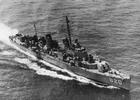 | 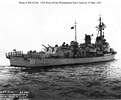 | 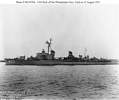 | 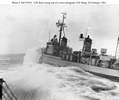 | 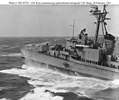 |
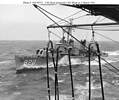 |
 |  |  | 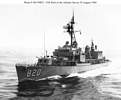 | 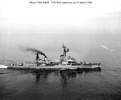 |
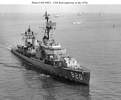 |  | 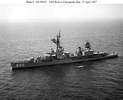 | 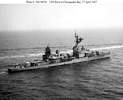 | 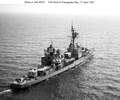 |
 |  |
 Back to Destroyers list.
Back to Destroyers list.  Back to ships list.
Back to ships list.  Back to selection page.
Back to selection page.  Back to 1st page.
Back to 1st page.